How to make the perfect arancini
Are these fried rice balls the best use for leftover risotto, do you make them from scratch in the traditional Sicilian style, and what do you stuff them with?
Arancini, named after the little oranges that these fried rice balls are said to resemble, are best known in this country as a handy way to use up leftover risotto. In fact, they hail from a land far too sun-baked to have developed much of a taste for rich, starchy rice dishes. Indeed, they are said to have been introduced to Sicily by the Arab invaders who also brought rice to the island in the 10th century and, according to Giorgio Locatelli in The Food of Sicily, have only latterly been adopted by the traditional risotto belt far to the north.
He reckons they would have fulfilled much the same function as a pasty in this country – the perfect portable, high-energy snack for a day’s work in the fields or out on fishing boats. Antonio Carluccio describes them as the Sicilian equivalent of “a sandwich at lunch”. They also make ideal picnic fare and, thanks to their ability to soak up large amounts of alcohol, unsurpassable party food.
Perhaps because they’re Sicilian, but more probably because they’re so simple, few of my trustiest Italian cookery books include recipes for arancini: Marcella Hazan, Elizabeth David and Anna Del Conte are all silent on the subject. But, though any fried rice ball is a welcome fried rice ball as far as I’m concerned, mine can tend towards the bland and stodgy. Just how do you make a perfect one?
The rice
Angela Hartnett and Carluccio use risotto to make their arancini. “It’s better”, according to the latter – but then Hartnett’s Italian family is based in Emilia-Romagna, while Carluccio grew up in Piedmont, so they’re bound to be keener on risotto than your average Sicilian. The classic Italian cookbook Silver Spoon astounds me by using boiled long-grain rice for its supplì al telefono, a Roman rice croquette similar to arancini, which takes its name from the long “telephone wires” of melted mozzarella that are said to stretch out when you take a bite.
Locatelli says that in his home region of Lombardy, arancini are made from leftover saffron risotto, but “the Sicilian way is to boil the rice in water with saffron added”. Instead of stirring the rice to release its creamy starch, as one would with risotto, the grains are left alone, so “the rice retains its ‘soul’, its inner shape”, but, “by boiling it in the right quantity of stock or water it will absorb all the liquid as it cools down gently, and by the time it is completely cold it will be very sticky”. He’s right, it is – though I don’t think you need to leave it overnight, as his due zie, or two Sicilian aunty-advisors, claim.
I also experiment with different temperatures of risotto, from the warm recommended by Sicilian legend Anna Tasca Lanza, who reckons the rice “gets difficult to shape as it cools”, to the chilled stuff Nigel Slaterregards as essential for success, via Hartnett’s cooled variety. I decide that you must have to be a real Sicilian to find it easier to shape hot – mine are impossibly fragile, and all fall apart in the pan. (Yotam Ottolenghi is of the same mind).
Whether you’re using risotto or the simpler method recommended by Locatelli, it is far easier to allow the rice to cool and absorb any excess liquid before attempting anything further – I don’t find much difference between the cool and chilled versions, but the latter is an infinitely better bet from a food safety point of view. Without leftover risotto burning a hole in the fridge, however, I prefer the firmer texture and faster preparation of Locatelli’s version to Hartnett and Carluccio’s richer, creamier recipes. The Silver Spoon’s long grain is appreciably less sticky, and thus drier and harder to work with.
Binders
Carluccio, Tasca Lanza and the Silver Spoon all add egg to their risotto bases to bind it (which, in Carluccio’s case, makes his filling almost wet), but if you’ve cooked your rice right, and it’s cool enough, it shouldn’t need it. That said, unless you’ve made Hartnett’s gloriously buttery and cheesy basic risotto as your base, adding a fistful more grated parmesan while it’s still warm, as Locatelli suggests, helps with flavour and texture. You can really never have too much cheese in this situation.
Fillings
Far be it from me to pronounce on the merits of the different fillings for arancini – you can keep it simple, as with the Silver Spoon’s mozzarella and shredded ham, or complex, as with Locatelli’s ragu with peas and cheese, though I think molten mozzarella is probably mandatory. Cutting that mozzarella up into small pieces and distributing it throughout the filling, as in Hartnett and the Silver Spoon’s recipes, rather than just stuffing a piece into the centre, makes the arancini more interesting to eat. I’ve stuck with the classic saffron to flavour the rice, but feel free to experiment with other herbs and spices; Hartnett goes for chopped parsley and Carluccio adds a pinch of nutmeg, but chilli flakes might also work well with the bland mozzarella.
Shell
The Silver Spoon and Hartnett use the classic flour, egg and breadcrumb coating, while Carluccio pares it down to just egg and breadcrumbs, which is harder to stick to the rice. I’m sold on Locatelli’s Sicilian pastella, or batter, a mortar layer of egg, flour and water that goes on before the breadcrumbs and makes the shell crisp and robust, even when the arancini are left to cool, as they would traditionally be in their homeland. Hartnett uses fresh breadcrumbs, but I prefer the crisper texture of the dried variety with the soft rice inside, though I don’t think they need to be as finely ground as Locatelli’s.
Shaping and cooking
As the name suggests, arancini are classically quite large, whether they’re round or conical, though now they are more popular as antipasti, they are shrinking: Locatelli suggests making them the size of a tangerine, Carluccio an apricot, and Hartnett gives a diameter of 4-5cm. Adjust to suit the occasion, but Hartnett’s measurements seem about right to me. Almost everyone deep-fries their arancini – Carluccio suggests shallow-frying, which does work, but involves far more faffing about and sacrifices a degree of crispness to bootIf your concern is health-related, bear in mind that arancini probably shouldn’t be a regular part of your diet anyway. And if it’s financial, well, unless you live somewhere where olive oil is cheaper than the vegetable sort, the latter is absolutely fine here. This is a dish you can make almost entirely from leftovers, after all.
The perfect arancini
(Makes 10 medium balls)
800ml chicken or vegetable stock
250g arborio rice
½ tsp salt
Very generous pinch of saffron
50g parmesan or vegetarian alternative, grated
150g mozzarella, chopped into chunks
Fillings of your choice (meat ragu, pesto, sauteed mushrooms)
1 egg
170g plain flour
500g dried breadcrumbs
Vegetable oil, to cook
If you are using leftover risotto, skip this step. Otherwise, bring the stock to the boil in a medium pan, then tip in the rice, salt and saffron. Bring back up to the boil, then turn down the heat and simmer on a medium heat until the stock has been absorbed. Stir in the grated parmesan and season to taste, then leave to cool completely, preferably in the fridge – you can spread it out on a tray to hasten this if necessary.
Stir the mozzarella into the cool rice and check the seasoning. Roll a tablespoonful between wet palms to form a ball of your chosen size. Poke a hole in the middle and spoon your filling in, then plug the hole with extra rice. Repeat until all the rice is used up.
Beat together the egg, flour and enough water to make a thick batter (about 175ml), and season. Put the breadcrumbs on to a plate.
Heat the oil in a deep pan, no more than a third full, to 170C, or until a breadcrumb sizzles on contact. As it is heating, dip each rice ball into the batter to coat, then into the breadcrumbs, heaping them on top until it is well covered.
Cook in batches until golden brown, making sure the oil comes back up to temperature between batches, and drain on kitchen towel. Sprinkle with a little salt while still warm and serve hot or cold.
Source: Theguadian


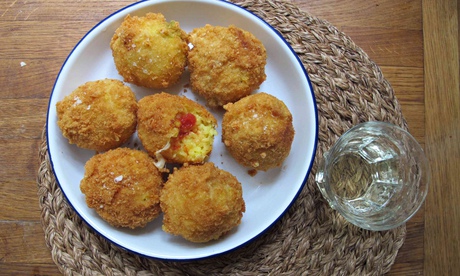
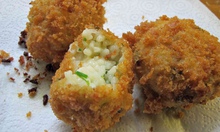
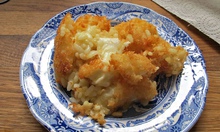
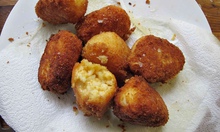
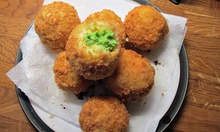
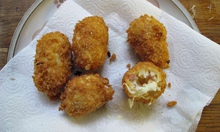
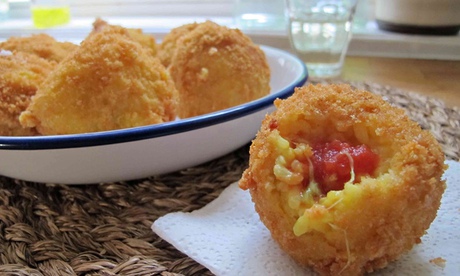
Comments